MACHINE LEARNING APPLICATIONS FOR OPTIMISING QUANTUM NANOTECHNOLOGY IN RENEWABLE ENERGY PRODUCTION AND SUSTAINABLE GREEN SYSTEMS
Authors :
Sanaz Siti and Feghhi Mahmoud
Address :
Department of Electrical Engineering, Azarbaijan Shahid Madani University, Tabriz, Iran
School of Information Technology and Engineering, Vellore Institute of Technology, Tamil Nadu
Abstract :
Renewable energy generation and encouraging environmentally friendly green systems can be revolutionised by merging with automated learning and quantum nanotechnology. The reduction of energy consumption, system reliability prediction, and architecture enhancement of quantum dot-based solar energy systems are the primary goals of the present study, which uses automated learning methods, namely LSTM Neural Networks. Machine learning algorithms allow for precise energy production and system operation prediction by assessing material qualities, ambient conditions, and time-lapse energy information. Learning through reinforcement is a valuable tool to further improve resource generating procedures in real-time, with adaptive management and decreased energy losses. The investigation shows that solutions based on information significantly increase yield optimisation while enhancing energy consumption estimates by 15-20%. Furthermore, conventional energy sources may be made more sustainable in the long run by including nanoscale components, which reduce power loss. This research investigation highlights the possibility of solving energy problems, encouraging creative thinking, and adding to a cleaner, more effective worldwide energy system by integrating quantum nanotechnology with sophisticated machine learning techniques.
Keywords :
Quantum nanotechnology, machine learning, quantum dot solar cells, neural networks, renewable energy optimisation
1.Introduction
Growing demand for electricity worldwide and climate change make the switch towards renewable energy that is environmentally friendly vital [1]. Atomic nanotechnology, particularly atomic dot-based solar cells and complicated nanomaterials might improve energy conversion effectiveness. These advancements can optimise green energy systems, especially with machine learning (ML) [2]. A significant challenge is attempting to enhance quantitative and nanotechnology-based renewable energy performance while simultaneously minimising energy losses. Conventional experimentation refining is tedious and highly resource-intensive. The present research uses ML and nanoscale nanoparticles to build models for forecasting and energy efficiency improvement tactics [3]. Controlled and supervised learning are the main ML methods.
Reinforced learning techniques estimate the efficiency of solar cells using microscopic dot substance parameters and ambient conditions, including generated electricity metrics from massive data sets. Reinforcement learning methods continuously alter the solar electricity system parameters of operation to optimise instantaneous fashion generation of electricity [4].
The present study offers various achievements:
- Machine learning algorithms outperform conventional predicting approaches when it comes to accurately predicting the efficiency of quantum dot solar cells according to various conditions [5].
- Optimising efficiency and reducing loss of electricity in immediate green energy systems is achieved using the dynamic approach Optimisation for Reinforcement Learning [6].
- Combining Intelligence with nanotechnology indicates that solar power plants can be built with scalability, reliability, and efficiency by integrating neural networks with state-of-the-art atomic substances.
The following section is how the document is organised: Part 2 provides a literature study on quantum nanotechnology and machine learning as they pertain to renewable energy. Methodology, including data collecting, model building, and validation, is detailed in Section 3. Section 4 lays out the critical results, and Section 5 delves into what those results mean. Directions for further study are provided in Section 6.
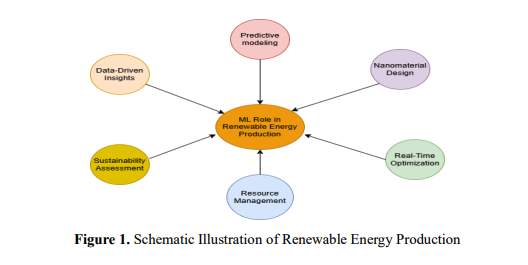
2. Literature Survey
Suresh et al. [8] Evidence through scientific data depository systems, power source investigations, and trials show improved energy efficiency, trustworthy substance predictions, and procedure flexible thinking. Data volumes, computing costs, and design extensions are hurdles. Investigating intelligent energy and solar power integration emphasises the responsible role of sustainable nanotechnology in energy developments. This research combines nanotechnology with deep learning to improve energy storage methods for environmental sustainability. Nanotechnology, including capacitors, thermal memory, and rechargeable batteries, can benefit from neural networks. Meanwhile, automated methods provide fast charging, real-time monitoring, and intelligent battery control.
Konstantopoulos et al. [9] The present research optimises nanomaterial development and production using artificial Intelligence and high-throughput prediction models. Material science libraries, nanotechnology experimental information sets, and modelling outputs are used for training and validation. Findings show improved material exploration, nanomaterial behaviour prediction, and resource-efficient production. Limitations include handling large multivariate datasets, significant processing costs, and difficulty extrapolating models across environmental circumstances. This research integrates machine learning to allow secure, effective, and sustainable nanomaterial production and handle information-driven challenges.
Sharma et al.[10] The methods utilising machine learning used in the present investigation to forecast thermophysical parameters and maximise the efficiency of heat transfer in nanofluid-based energy sources include artificial neural networks (ANNs), Boosted Regression Techniques, K-means, KNN, CatBoost, and XGBoost. The data sets include simulation findings, observational thermophysical parameter data, and nanofluid technology thermal activity recordings. These results show improved heat conveyance performance, greater forecasting precision, and amplification of significant impacting elements. Limitations still exist, though, including the black-box nature of artificial neural networks, inconsistent data from different research, and a demand for resources for computation. This investigation demonstrates how algorithmic learning may handle intricate thermophysical estimates, enhancing both renewable energy sources' sustainability and effectiveness.
Pareek et al.[11] Nanomaterials' structure, production, characteristics, security, toxic effects, and lifecycle assessment (LCA) are investigated in this research using ML methods with the value as Random Forests, Gradient Boosting, Support Vector Machines (SVM), and Artificial Neural Networks. The information sets encompass the results from stabilisation tests, investigations on tiny material fabrication, cytotoxic data, and life cycle assessment statistics. The outcomes show that interdependency patterns detection, design of materials, and ecological impact anticipates are all strengthened. The difficulties in expanding results for applications in industry, data variability, and the lack of readability in ML models constitute a few drawbacks. The investigation demonstrates the potential of ML to identify designs which could contribute to improved security and environmental nanomaterial manufacturing.
Wang et al.[12] These compounds, graphite, and carbon nanotubes are (CNMs) being investigated for the possibility of cytotoxicity in fields as diverse as medical treatment, farming, power generation, and aesthetics using ML techniques, including Support Vector Machines (SVM), Random Forest, Neural Networks, and Gradient Boosting. Research on toxicology, information on human beings, and records regarding environmental connections are all part of the databases. The findings show that risk estimation is better than standard detecting approaches, and contaminant tendencies are identified with greater precision in forecasting. Information discrepancies, a lack of accessible exceptional information sets, and issues in making algorithms comprehensible are some of the drawbacks. This study guarantees nanomaterials' more secure and environmentally conscious uses, demonstrating ML's capacity to transform CNM toxicology evaluation
El-Azazy et al.[13] For purposes of enhancing the manufacturing, chemical properties, and utilisation effectiveness of carbon quantum dots (CQDs) in water treatment and electrochemical techniques, the present research utilises machine learning (ML) techniques such as supported vector machines (SVM), Artificial Neural Networks (ANN), and Random Forests. The databases contain recordings of adsorption of pollutants efficacy, research synthesising variables, and fluorescent emission spectrum. The findings indicate that the manufacture of CQDs is more precise, that pollutants can be detected at femtomolar concentrations with more responsiveness, and that electrocatalytic performance for HER is up. However, there are still certain issues with comprehending the processes of CQD-pollutant interaction, generalising models to other contexts, and synthesising scalability. This study emphasises the importance of ML in developing CQD applications, providing long-term answers to problems like water purification and renewable energy production.
3. Proposed system
a. System Overview
An LSTM Neural Network's process for forecasting energy amounts in renewable energy sources is shown in the design. The procedure begins with gathering data from many sources, such as energy systems and monitors. The next phase is to prepare this information, involving tasks like standardisation and selecting features. All three layers of the LSTM model architecture—the Input, the LSTM, and the Dense—are responsible for sequence simulation. Training Data (MSE) is used to train the model, while Validating Data (RMSE) is utilised to verify it. Future cost of energy estimates are established. The last stage is to optimise and fine-tune the model to improve the precision of forecasts.
b. Data Pre-processing and Feature Engineering
This component pre-processes and transforms unstructured information from renewable energy sources into an organised time-series data format to ensure it may be analysed.𝑃𝐿𝐴𝑁𝑇−𝐼𝐷, 𝑆𝑂𝑈𝑅𝐶𝐸−𝐾𝐸𝑌,𝐷𝐶−𝑃𝑂𝑊𝐸𝑅, AC_POWER, DAILY_YEILD, and TOTAL _YELD are among the fields in the dataset that are recorded at intervals of fifteen minutes. Time stamps (𝐷𝐴𝑇𝐸_𝑇𝐼𝑀𝐸) have been standardised to guarantee uniformity, and interpolation by linearity is used to fill in any information that is missing.
For instance, 200 + (220−200) 2 = 210𝑘𝑊 is the empty value if 𝐷𝐶−𝑃𝑂𝑊𝐸𝑅 is absent during two timestamps with levels of 200 kW and 220 kW. Analytical boundaries like the 1.5𝑥 times Interquartile Range (IQR) are used to identify abnormal values, especially measures of electrical power that are abnormally high or low. To help the model recognise time-based data, the day of the week in question and the hourly rate of the workday are also retrieved. Mathematical characteristics lie within the range [0,1], and the processed data set becomes normalised with Min-Max Scaling. During this stage, data collection is prepared for time-series data modeling, which guarantees precise forecasts for every single energy measure.
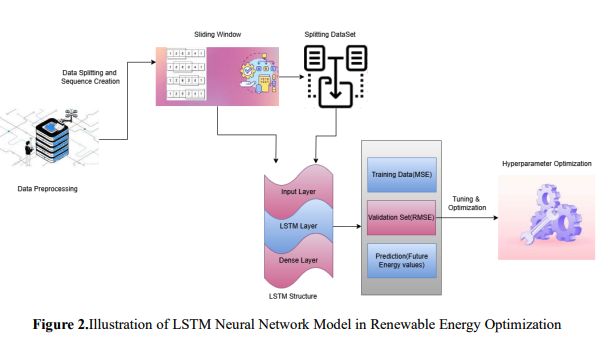
c. LSTM Neural Network for time-series predictions
Energies projections for output (such as DC_POWER and AC_POWE R) are the primary emphasis of this module's LSTM Neural Network design and learning process. A combined amount of three subsets— 70% for training, fifteen per cent for confirmation, and 15% for testing—make up the dataset. For instance, out of 10,000 entries in the dataset, around 7,000 are utilised for training purposes, 1,500 are reserved for validation, and 1,500 are used for testing. Examples of sequences created using windowsliding methods include predicting a subsequent energy value based on the last four time stamps (one hour). A compact output level, a layer that drops out, an input layer, and an invisible LSTM layer make up the LSTM model. Programs trained using optimisation algorithms such as Adam Optimization reduce the reduction in the function of Mean Squared Error (MSE). The model anticipates a value of 240 as the following Input if the ordering (DC_POWER) includes measurements such as [200, 210, 220, 230]. Training will continue to ensure that the model performs adequately on newly acquired information until its validation loss stabilises.
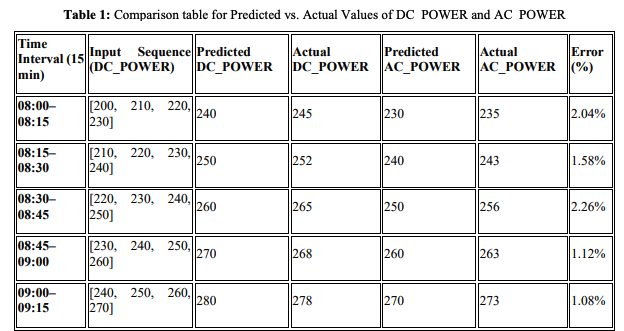
d. Model Evaluation and Optimisation of RMSE
The model used by LSTM is assessed after learning. Important indicators of performance are computed, including. 𝑅 2 Score, Mean Absolute Error (MAE), and Root Mean Squared Error (RMSE). For instance, the power source inaccuracy is computed as follows: Error = (250 − 240) = 10 kW if the actual value is 250 kW and the projected 𝐷𝐶−𝑃𝑂𝑊𝐸𝑅 is 240 kW.The error is calculated as:
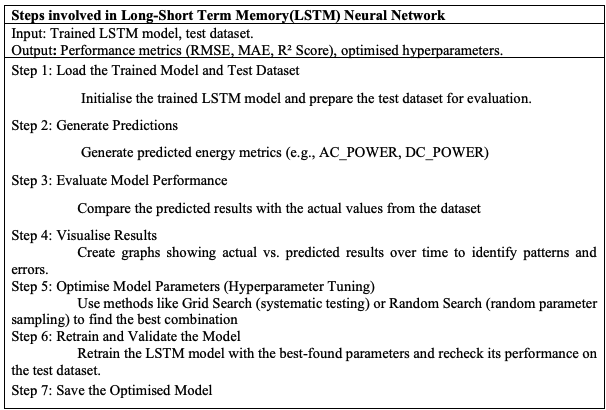


Where the number of forecasts is𝑛. The algorithm is dependable if the RMSE is small (5–10 kW). The analysis of errors helps locate anomalies where estimates differ considerably, including during significant energy demand. Algorithms like Grid Search are used for hyperparameter tweaking, including changing dropout rates and layer widths. Periodic or routine variations are shown by periodically comparing anticipated and observed energy expenditures using visualisation applications like time-lapse graphs.
Deploying the learned model in real-time conditions for ongoing renewable energy surveillance and management is the main objective of the last component. Every 15 minutes, the LSTM model processes incoming information on a cloud computing platform (such as AWS or Google Cloud). For example, the model anticipates the following values at 9:15 AM after acquiring inputs such as 𝐷𝐶−𝑃𝑂𝑊𝐸𝑅: 230 𝑘𝑊, 𝐴𝐶−𝑃𝑂𝑊𝐸𝑅: 220 𝑘𝑊 and 𝐷𝐴𝐼𝐿𝑌−𝑌𝐼𝐸𝐿𝐷: 1200 𝑘𝑊ℎ at 9:00 AM. Viewing these forecasts on dashboards, utility controllers may track system efficiency and spot power-generating irregularities. Practical suggestions are also produced, including suggesting more significant power conservation during high output periods or enhancing battery schedule charging. According to these forecasts, predictive control mechanisms modify the allocation of resources, increasing productivity and lowering energy waste. The model's predictive power is maintained throughout time by continuous learning with additional information.
4. Result analysis
a. Mean Squared Error (MSE)
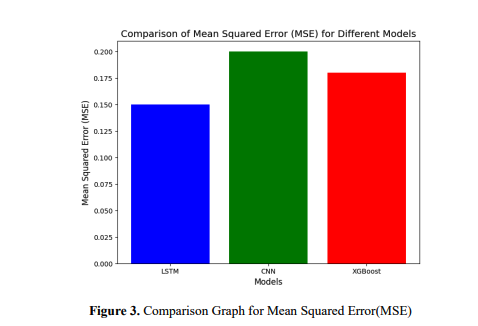
The Mean Squared Error (MSE) for three distinct ML models—LSTM, CNN, and XGBoost—is shown in the horizontal portion of the graph. To optimise the production of energy predictions and nanomaterial development in solar and wind power systems, a lower MSE suggests improved accuracy for prediction.
The best framework for energy-related uses involves microscopic nanotechnology; the table shows how every model behaves about error elimination.
b. R-Squared (R²) Score
The software is supplied to create a graph with bars to compare the R-squared (R²) scores obtained from three distinct statistical models—LSTM, CNN, and XGBoost. The measure of the extent to which an algorithm matches the information on how energy is produced is the R² score, which demonstrates what percentage of the dataset's variance (such as DC_POWER and AC_POWER) is explained by the model. Models with higher R² principles improve the conductivity of nanomaterials for use in solar energy systems and are better able to forecast energy outputs. Enhancing the use of quantitative nanoparticles in renewable energy systems is a top priority. Hence, this study assesses the mathematical models according to their accuracy in forecasting
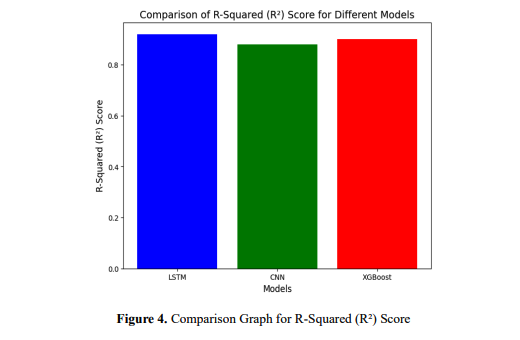
5. Conclusion and Future Enhancements
This work optimises quantum nanotechnology for renewable energy and green technologies. A comparison of MSE and R² efficiency metrics for LSTM, CNN, and XGBoost indicates the potential for generating electricity and nanotechnologies the optimisation accuracy in predicting. For the production of energy projections, LSTM fared well in time-series data, though XGBoost and CNN functioned well in system functioning predictions and nanotechnologies assessment. Integrated grids, adaptable storage systems, and nanomaterial research may benefit from machine learning, enabling cleaner, more environmentally friendly power solutions. Prospective studies might use deep reinforced learning and models using transformers to improve model performance with complex, high-dimensional data. Scaling these models to larger datasets combined with continuous surveillance optimises energy systems. The quantum nanoparticle activity may be studied using sensors and environmental information to enhance predictions and efficiency. Mainly highlight examples of easy-to-understand techniques, ethical AI use, and transparency regarding environmentally friendly power generation decision-making processes.
References :
[1]. Omer, A. M. (2008). Energy, environment and sustainable development. Renewable and sustainable energy reviews, 12(9), 2265-2300.
[2]. Al-Shetwi, A. Q. (2022). Sustainable development of renewable energy integrated power sector: Trends, environmental impacts, and recent challenges. Science of The Total Environment, 822, 153645.
[3]. Dincer, I. (2000). Renewable energy and sustainable development: a crucial review. Renewable and sustainable energy reviews, 4(2), 157-175.
[4]. Ahmed, R., Sreeram, V., Mishra, Y., & Arif, M. D. (2020). A review and evaluation of the state-of-theart in PV solar power forecasting: Techniques and optimisation. Renewable and Sustainable Energy Reviews, 124, 109792.
[5]. Ferreira, R. A., Correia, S. F., Fu, L., Georgieva, P., Antunes, M., & André, P. S. (2024). Using machine learning, predict the efficiency of luminescent solar concentrators for solar energy harvesting. Scientific Reports, 14(1), 4160.
[6]. Yang, T., Zhao, L., Li, W., & Zomaya, A. Y. (2020). Reinforcement learning in sustainable energy and electric systems: A survey. Annual Reviews in Control, 49, 145-163.
[7]. Alrababah, Aysar. "Hadoop-Based Political and Ideological Big Data Platform Architecture and Pattern Mining in Higher Education." PatternIQ Mining.2024, (1)2, 52- 64. https://doi.org/10.70023/piqm24125
[8]. Suresh, A., Taj, G. S., Shukla, M. R., Chaudhari, D., & Malathi, K. (2025). Deep Learning Empowered Nanotechnology and Energy Storage for Sustainable Environmental Preservation. In Introduction to Functional Nanomaterials (pp. 70-78). CRC Press.
[9]. Konstantopoulos, G., Koumoulos, E. P., & Charitidis, C. A. (2022). Digital innovation enabled nanomaterial manufacturing, machine learning strategies and green perspectives. Nanomaterials, 12(15), 2646.
[10]. Sharma, P., Said, Z., Kumar, A., Nizetic, S., Pandey, A., Hoang, A. T.,& Tran, V. D. (2022). Recent advances in machine learning research for nanofluid-based heat transfer in renewable energy systems. Energy & Fuels, 36(13), 6626-6658.
[11]. Pareek, A., Zafar, M., Lakshminarayanan, R., & Joshi, S. J. (2021). Nanotechnology for green applications: How far on the anvil of machine learning! Biobased Nanotechnology for Green Applications, 1-38.
[12]. Wang, L., Wang, H., Bai, M., Wu, Y., Guo, T., Cai, D., & Ming, W. (2024). A comparative review: research in safety and sustainability of carbon nanomaterials without and with machine learning assistance. IEEE Access.
[13]. El-Azazy, M., Osman, A. I., Nasr, M., Ibrahim, Y., Al-Hashimi, N., Al-Saad, K., & El-Shafie, A. S. (2024). The interface of machine learning and carbon quantum dots: From coordinated innovative synthesis to practical application in water control and electrochemistry. Coordination Chemistry Reviews, 517, 215976.